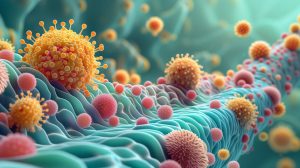The less a worm of the species Caenorhabditis elegans (C. elegans ) eats , the slower it loses its fat. Now scientists at Scripps Research have discovered why this is the case: a small molecule produced by the worms’ gut during fasting travels to the brain and blocks a fat-burning signal during this time. Although the exact molecule they have identified in the worms has not yet been studied in humans, the new work helps scientists to better understand the complex interaction between the gut and brain. It could also shed light on why fasting – abstaining from food for a period of time – has benefits that are independent of the amount of calories a person consumes. The new study was published in Nature Communications onAugust 11, 2024.
The researchers led by Supriya Srinivasan, Scripps Research Professor of Neuroscience, PhD, lead author of the new study, have found for the first time that fasting transmits information to the brain that goes beyond mere calorie deprivation. These findings lead them to wonder if there are molecules produced in the guts of other animals, including mammals, that explain some of the health effects associated with fasting.
Insulin Molecule Produced by Gut Cells Affects Fat Metabolism Via the Brain
Researchers have long known that the brain controls the production and breakdown of fats in humans, other mammals and model organisms such as C. elegans. In 2017, Srinivasan’s group identified FLP-7, a brain hormone that stimulates fat burning in the gut of the nematode. However, C. elegans have no sensory nerves in their gut, so the scientists struggled to decipher the reverse communication pathway: How does the gut signal the brain? The experts knew that changing the metabolism in the gut can alter the properties of neurons in the brain, but it was very puzzling how this actually happens.

However, when the group investigated how INS-7 affected the FLP-7-producing brain cells, they found that it did not activate the insulin receptors – like all previously discovered insulin molecules – but blocked the insulin receptor. This blockade in turn set in motion a cascade of other molecular events that eventually caused the brain cells to stop producing FLP-7. According to Srinivasan, INS-7 is basically a signal from the gut that tells the brain not to burn any more fat stores at the moment because no food is being supplied.
Signals Between Gut and Brain Control Metabolism
Studies have already shown that periods of fasting can affect the body in various ways, but the mechanisms of these changes were previously unclear. The new study points to one way in which an empty gut can signal the brain, potentially leading to a range of health effects beyond fat. The new findings, Srinivasan said, help explain how the brain and digestive system communicate in both directions to control metabolism in response to food availability.
Further research is needed to determine which specific pathways in mammals are involved in the new signals between the gut and brain. Compounds that mimic gut hormones – such as semaglutide, known by brand names such as Ozempic, Wegovy and Rybelus – have recently proved popular in the fight against obesity and diabetes, so new gut peptides could complement this class of drugs. Srinivasan is also planning experiments to study how C. elegans intestinal cells are stimulated to produce INS-7 during fasting and what types of brain cells are affected by the molecule.







